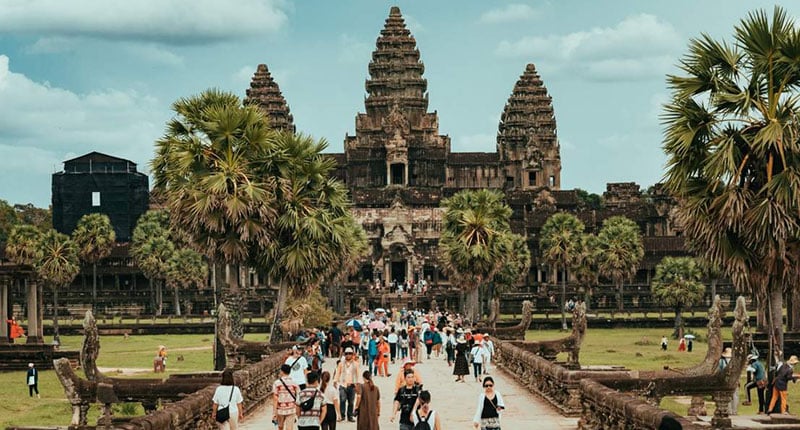
Exploring Angkor Wat: A Historical Guide
Angkor Wat, one of the most magnificent archaeological wonders in the world, stands as a testament to the ancient Khmer civilization’s architectural and artistic brilliance. Located in Cambodia’s Siem Reap province, this majestic temple complex beckons history enthusiasts, spiritual seekers, and curious travelers from all corners of the globe. This historical guide invites you to delve into the rich past of Angkor Wat, exploring its captivating history, intricate architecture, and spiritual significance.
Angkor Wat, built during the early 12th century by King Suryavarman II, was originally intended as a Hindu temple dedicated to the god Vishnu. It later transformed into a Buddhist temple, reflecting the religious evolution of the Khmer Empire. The temple’s name itself translates to “City of Temples,” hinting at the awe-inspiring structures that await visitors within its complex.
The History of Angkor Wat
Origins and Construction
The construction of Angkor Wat spanned several decades, employing thousands of laborers and skilled artisans. Its unique blend of sandstone and laterite blocks, coupled with intricate carvings, showcases the Khmer’s architectural prowess.
The Golden Era of Angkor Wat
During the reign of King Jayavarman VII, Angkor Wat reached its golden era. The temple complex flourished as the capital city, witnessing an era of prosperity, art, and cultural advancements.
Decline and Rediscovery
Following the decline of the Khmer Empire, Angkor Wat faced neglect and was gradually reclaimed by nature. It wasn’t until the 19th century that the temple complex was rediscovered by French explorers, sparking global interest in this historical treasure.
The Architecture of Angkor Wat
Layout and Design
Angkor Wat’s architecture is a mesmerizing fusion of symmetry and symbolism. The temple is designed to represent Mount Meru, the sacred abode of the gods in Hindu mythology, surrounded by a vast moat symbolizing the cosmic ocean.
Symbolism and Artwork
Every inch of Angkor Wat’s walls and corridors is adorned with intricate bas-reliefs and carvings. These depict epic tales, celestial beings, and scenes from everyday life, providing a visual narrative of the Khmer Empire’s history and beliefs.
Exploring the Main Structures
Central Temple: Angkor Wat
The central temple itself is a masterpiece of Khmer architecture. Its five soaring towers, representing the five peaks of Mount Meru, are an iconic symbol of Cambodia.
The Five Towers
Each tower within the central temple holds unique significance, housing statues of deities and embodying the spiritual essence of Angkor Wat.
Bas-Reliefs and Carvings
The extensive bas-reliefs and carvings offer a glimpse into Khmer society, showcasing agricultural practices, battle scenes, and religious rituals.
Surrounding Temples and Structures
Bayon Temple
Located in the ancient city of Angkor Thom, the Bayon Temple is renowned for its enigmatic smiling faces carved into the stone towers, believed to represent Avalokiteshvara, the Bodhisattva of Compassion.
Ta Prohm Temple
Known as the “Tomb Raider Temple” due to its appearance in the Hollywood movie, Ta Prohm is a captivating sight with tree roots entwined around the ancient ruins.
Banteay Srei
Famed for its intricate pink sandstone carvings, Banteay Srei is a smaller yet equally enchanting temple that offers a glimpse into the delicate artistry of the Khmer Empire.
Angkor Wat in Modern Times
Conservation Efforts
As a UNESCO World Heritage Site, Angkor Wat is now under conservation efforts to preserve its grandeur for future generations.
Tourism and Sustainability
The surge in tourism brings both opportunities and challenges, prompting the need for sustainable practices to protect this historical marvel.
Tips for Visiting Angkor Wat
Best Time to Visit
To make the most of your experience, plan your visit during the cooler months to avoid the scorching heat.
Dress Code and Etiquette
Respect the sacred nature of the site by dressing modestly and adhering to the temple etiquette.
Navigating the Site
Given the vastness of the complex, consider hiring a knowledgeable guide to explore Angkor Wat’s hidden treasures.
The Spiritual and Cultural Significance
Angkor Wat holds immense spiritual and cultural significance for the Cambodian people, symbolizing the nation’s resilience and enduring spirit.
Conclusion
Angkor Wat, a living testament to the ingenuity of the Khmer civilization, continues to inspire awe and wonder among those who visit it. As you explore this historical site, let the intricate carvings and majestic architecture transport you back in time to an era of grandeur and artistic brilliance. Embrace the spiritual energy that permeates the air and be humbled by the legacy of an ancient civilization that still echoes through the halls of Angkor Wat.
FAQs
1. Can I visit Angkor Wat at any time of the year?
- Yes, you can visit Angkor Wat throughout the year, but the best time is during the cooler months from November to February.
2. Are there any dress code restrictions while visiting Angkor Wat?
- Yes, visitors are required to dress modestly, covering their shoulders and knees as a sign of respect for the sacred site.
3. How long does it take to explore the entire Angkor Wat complex?
- To explore the main highlights, allocate at least one to two days. For a more in-depth experience, consider spending three to four days exploring the entire complex.
4. Are there any guided tours available?
- Yes, guided tours with knowledgeable local guides are available, offering insights into the history and significance of Angkor Wat.
5. How can I contribute to the preservation of Angkor Wat?
- You can contribute to the preservation efforts by being a responsible and sustainable traveler, respecting the rules and regulations set by the authorities.











